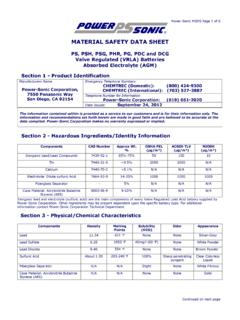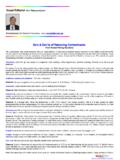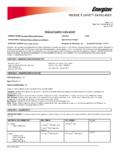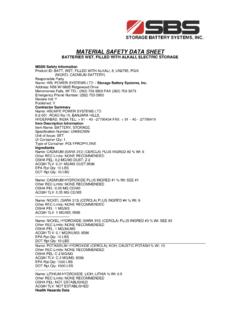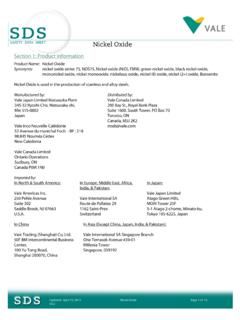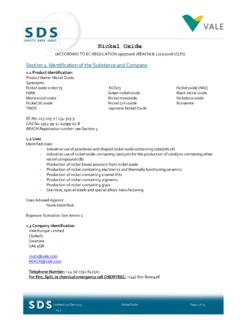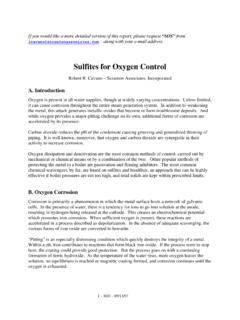Transcription of Safety data sheet for chemical products (SDS)
1 product name: nickel -Metal Hydride Battery Establishment / Revision: Jan. 13, 2010 1 Reference number TW-CE-E01-08 Safety data sheet for chemical products (SDS) AND COMPANY IDENTIFICATION product name : nickel -Metal Hydride Battery Supplier s Name : FDK CORPORATION Supplier s Address : 5-36-11 Shinbashi Minato-Ku, Tokyo, Japan Telephone number : +81-3-3434-1022 Manufacturer s Name : FDK TWICELL CO., LTD. Manufacturer s Address : 307-2 Koyagi-machi, Takasaki City, Gunma, Japan Telephone number : +81-27-361-7575 IDENTIFICATION Most important hazard and effects For the battery cell, chemical materials are stored in a hermetically sealed metal case, designed to withstand temperatures and pressures encountered during normal use.
2 As a result, during normal use, there is no physical danger of ignition or explosion and chemical danger of hazardous materials' leakage. However, if exposed to a fire, added mechanical shocks, decomposed, added electric stress by misuse, the gas release vent will be operated. The battery cell case will be breached at the extreme. Hazardous materials may be released. Moreover, if heated strongly by the surrounding fire, acrid or harmful fume may be emitted. Human health effects: Inhalation: The electrolyte inhalation affects the respiratory tract membrane and the lugs. Cadmium fume may cause a cough, chest pain and dyspnea. Bronchitis and pneumonia will be occurred. Probably, it is carcinogen.
3 Skin contact: The electrolyte skin contact affects the skin seriously and may cause dermatitis. Eye contact: The electrolyte leaked from the battery cell is strong alkali. When it goes into an eye, the cornea may be affected and it may lead to blindness. Ingestion: The electrolyte ingestion irritates the mouth and the throat seriously results in vomiting, nausea, hematemesis, stomach pains and diarrhea. Environmental effects: Since a battery cell remains in the environment, do not throw out it into the environment. Specific hazards : As previously described. / INFORMATION ON INGREDIENTS Substance or preparation : Preparation Information about the chemical nature of product .
4 Common chemical name / General name CAS number Concentration / Concentration rangeClassification and hazard labeling Hydrogen Absorbing Alloy 7440-02-0(Ni) 7440-48-4(Co) 7439-96-5(Mn) 7429-90-5(Al) 20-40% specific hazard nickel -Cobalt-Zinc oxide 7440-02-0(Ni) 7440-48-4(Co) 7440-66-6(Zn) 15-25% acute toxicity specific hazard nickel 7440-02-0 5-15% specific hazard Iron 7439-89-6 20-40% Carbon Black 1333-86-4 0-1% specific hazard Potassium Hydroxide 1310-58-3 Sodium Hydroxide 1310-73-2 Lithium Hydroxide 1310-65-2 0-15% acute toxicity corrosivity irritant property product name: nickel -Metal Hydride Battery Establishment / Revision: Jan.
5 13, 2010 2 MEASURES Internal cell materials of an opened battery cell Inhalation : Cover the victim in a blanket, move to the place of fresh air and keep quiet. Seek medical attention immediately. When dyspnea (breathing difficulty) or asphyxia (breath-hold), give artificial respiration immediately. Skin contact : Remove contaminated clothes and shoes immediately. Wash the adherence or contact region with soap and plenty of water. Seek medical attention immediately. Eye contact : Immediately flush eyes with water continuously for at least 15 minutes. Seek medical attention immediately. A battery cell and internal cell materials of an opened battery cell Ingestion : Do not induce vomiting.
6 Seek medical attention immediately. MEASURE Although a battery cell is not flammability, in case of fire, move it to the safe place quickly. The following measures are taken when it cannot be moved. Suitable extinguishing media: Dry sand, chemical powder fire extinguishing medium. Specific hazards: Acrid or harmful fume is emitted during fire. Special protective equipment for firefighters : Protective equipment written in Section 8. RELEASE MEASURES Internal cell materials, such as electrolyte leaked from battery cell, are carefully dealt with according to the followings. Personal precautions : Forbid unauthorized person to enter. Remove leaked materials with protective equipment written in Section 8.
7 Environmental precautions: Do not throw out into the environment. Method of recovery and neutralization : Dilute the leaked electrolyte with water and neutralize with diluted sulfuric acid. The leaked solid is moved to a container. The leaked place is fully flushed with water. AND STORAGE Handling Technical measures Prevention of user exposure: Not necessary under normal use. Prevention of fire and explosion: Not necessary under normal use. Precaution for safe handling: Do not damage or remove the external tube. Specific safe handling advice: Never throw out cells in a fire or expose to high temperatures. Do not soak cells in water and seawater. Do not expose to strong oxidizers.
8 Do not give a strong mechanical shock or throw down. Never disassemble, modify or deform. Do not connect the positive terminal to the negative terminal with electrically conductive material. In the case of charging, use only dedicated charger or charge according to the conditions specified by Sanyo. Storage Technical measures Storage conditions (suitable to be avoided): Avoid direct sunlight, high temperature, high humidity. Store in cool place (temperature: -20 ~ 30 degree C, humidity: from 40 to 80%). Incompatible products : Conductive materials, water, seawater, strong oxidizers and strong acids Packing material (recommended, not suitable): Insulative and tear-proof materials are recommended.
9 CONTROLS / PERSONAL PROTECTION Engineering measures : No engineering measure is necessary during normal use. In case of internal cell materials' leakage, the information below will be useful. Control parameters product name: nickel -Metal Hydride Battery Establishment / Revision: Jan. 13, 2010 3 Common chemical name / General name ACGIH(2008) TLV-TWA BEI nickel , nickel Compounds (As Ni) Metal : Soluble compounds : Insoluble compounds : - Cobalt Compounds (As Co) In urine : 15 micro g/l In blood.
10 1 micro g/l Manganese Compounds (As Mn) - Aluminum Compounds (As Al) 5mg/m3(Flammable powder) - Zinc oxide 2mg/m3 - Carbon Black - Potassium Hydroxide - - Sodium Hydroxide - - Lithium Hydroxide - - ACGIH: American Conference of Governmental Industrial Hygienists, Inc. TLV-TWA: Threshold Limit Value-time weighted average concentration BEI: Biological Exposure Indices Personal protective equipment Respiratory protection: Protective mask Hand protection: Protective gloves Eye protection: Protective glasses designed to protect against liquid splashes Skin and body protection: Working clothes with long sleeve and long trousers AND chemical PROPERTIES Appearance Physical state: Solid Form: Cylindrical and Prismatic Color: Metallic color (without tube/label) Odour: No odour pH : NA Specific temperatures/temperature ranges at which changes in physical state occur : There is no useful information for the product as a mixture.
